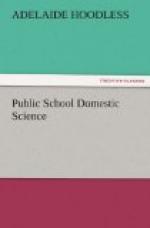BAKING.
Baking is cooking in confined heat. Meat properly cooked in an oven is considered by many authorities as quite equal in delicacy of flavor to that roasted before a fire, and is equally digestible.
STEAMING.
Steaming is cooking food over condensed steam, and is an excellent method for preparing food which requires long, slow cooking. Puddings, cereals, and other glutinous mixtures are often cooked in this way. It is an economical method, and has the advantage of developing flavor without loss of substance.
Food Preservation.
Food is preserved by the following processes: (1) drying, (2) smoking, (3) salting, (4) freezing, (5) refrigerating, (6) sealing, (7) addition of antiseptic and preservative substances.
DRYING.
Drying in the sun and before a fire is the usual method employed by housekeepers. Fruits and vegetables, meat and fish may be preserved by drying, the latter with the addition of salt.
SMOKING.
Smoking is chiefly applied to beef, tongue, bacon, ham, and fish, which are hung in a confined chamber, saturated with wood smoke for a long time until they absorb a certain percentage of antiseptic material, which prevents the fat from becoming rancid, and the albumen from putrefying. Well smoked bacon cut thin and properly cooked is a digestible form of fatty food, especially for tubercular patients. Smoking improves the digestibility of ham.
SALTING.
Salting is one of the oldest methods of preserving food. The addition of a little saltpetre helps to preserve the color of the meat. Brine is frequently used to temporarily preserve meat and other substances. Corned beef is a popular form of salt preservation. All salted meats require long, slow cooking. They should always be placed in cold water and heated gradually in order to extract the salt. Salt meats are less digestible and not quite so nutritious as fresh meats.
FREEZING.
Food may be kept in a frozen condition almost indefinitely, but will decompose very quickly when thawed, hence the necessity for cooking immediately. Frozen meat loses 10 per cent. of its nutritive value in cooking.
REFRIGERATING.
This process does not involve actual freezing, but implies preservation in chambers at a temperature maintained a few degrees above freezing point. This method does not affect the flavor or nutritive value of food so much as freezing.
SEALING.
Sealing is accomplished not only in the process of canning but by covering with substances which are impermeable. Beef has been preserved for considerable time by immersing in hot fat in which it was allowed to remain after cooling.
CHEMICALS.
Chemicals are sometimes used in the preservation of food, but the other methods are safer.




